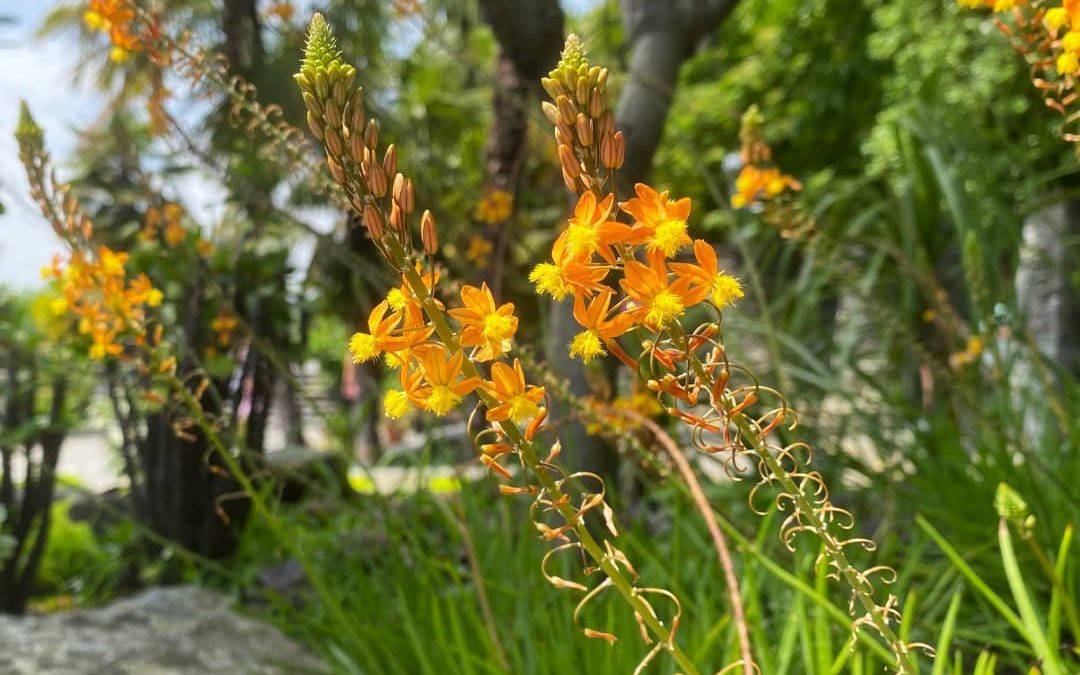How Do You Take Care Of Bulbine Plants?
Bulbine Plant care is relatively simple, as long as you provide it with the necessary conditions for it to thrive and flourish. The Bulbine is native to South America and has made its way to being one of the most popular plants in the country, especially in Florida. Once it blooms, the Bulbine produces flowers that come in shades of orange and yellow. These bright colors are fun and exciting and can help bring a touch of color to your garden space.
Will Bulbine Spread?
When the Bulbine plant reaches maturity, it will begin forming spreading colonies. This way, the plant will fill out any area that you plant it in, helping it become thick and full easily. In order for this to happen, you must provide it with adequate conditions for it to grow healthily and properly. Also, it’s important to take this into account when planting your Bulbine. You’ll want to take into account about two feet for each plant, as that is the length most mature plants can spread.
How To Divide Bulbine Plant?
The Bulbine plant is a rapid grower and has a tendency to spread outward. At first, this may look beautiful as the plant beings to fill out, and the color flowers start to bloom. After a while, though, the Bulbine may grow too tall or wide and will require some general maintenance. How will you know when it’s time to divide your Bulbine plant? That’s easy. The plant will begin to flop over on itself because it’s carrying too much weight and doesn’t have the strength to carry itself anymore. You’ll want to first dig up the plant that’s beginning to flow open. Dig them out by the roots and then divide them into smaller, individual plants. Take these plants and plant them on their own, making sure you leave enough room in between them to be able to grow without any interference. The best time of year to divide your Bulbine plant is before the rainy season begins in your region.
Is Florida A Bulbine Plant Zone?
One of the main reasons the Bulbine plant has because a garden staple in Florida is because of its ability to thrive in the state’s hot, extreme climates. The Bulbine plant is easy to care for, especially once you have it planted. This plant can grow and flourish in poor soil quality, so you don’t have to worry too much about the conditions of your garden or potting soil with this plant, as long as you also take care of its watering and sunlight needs. Although, that isn’t too difficult because Bulbine is also drought resistant, so if you’re looking for a plant that you don’t have to invest too much time or effort into, Bulbine is a great choice. Florida stays warm year round, which is another reason why Bulbine is perfect for this state. You’ll be able to enjoy beautiful blooms all throughout the year because as long as the weather is warm, the Bulbine will continue to bloom throughout most months of the year.
How Big Do Bulbine Plants Get?
The Bulbine plant is a wonderful foliage plant that can be used to decorate your garden and lawn. If you have larger plants, this is a great choice because it only grows about 1-1.5′ tall and about 2′ wide. So, you can grow this plant without worrying about it taking over your garden or blocking your other plant from the proper sun. Because of their growing length, you can easily grow this plant in pots and planters if you don’t have a space in your garden to grow them. Once the plant reaches its maturity length, taking care of it becomes a breeze. You won’t have to worry about this plant if the soil quality isn’t ideal or if the weather is too hot; this powerful plant is resistant to most of summer’s extremes and can continue to thrive throughout the year.
Common Bulbine Plant Problems
Root Rot
The Bulbine plant is a resilient plant that doesn’t come with many problems. The main issue you may encounter, as you will with any plant, is making sure you’re preventing root rot. Sometimes, if soil receives too much water, the plant is unable to absorb all of it adequately. Because of this, the soil remains wet, and the roots of the plant begin to rot due to constant exposure to moisture. The good news is that preventing root rot is easy. If your plant is outside in your garden, keep track of rainfall and allow your soil to dry out a bit before watering. The Bulbine Plant can handle dry soil well, so if you suspect issues going on with your plant, give it some time without water and continue to water the rest of your plants in the garden. Installing an irrigation system can help regulate your watering schedule and keep your plants healthy and vibrant. If you plan to grow your Bulbine in a planter, the same goes for allowing the soil to dry out before watering. Make sure the planter drains well and won’t cause water to sit in the bottom of the pot, causing the roots of the plant to rot. Other than root rot, this plant isn’t usually known for experiencing other issues.
A Low Maintenance Plant
The Bulbine is a unique plant that holds the magnificent aesthetic of natural South American foliage. Adding this plant to your garden is a great way to fill it out, add some color, and provide you with an easy plant that doesn’t take much tending to. If you’re still in need of assistance in planting your Bulbine plants, get in touch with our skilled landscape team today.






